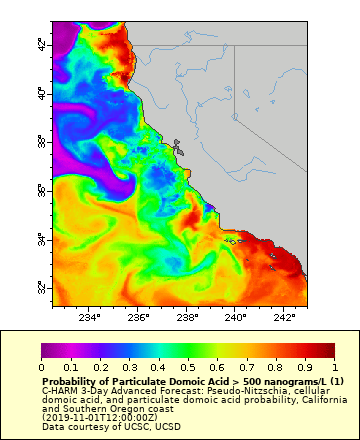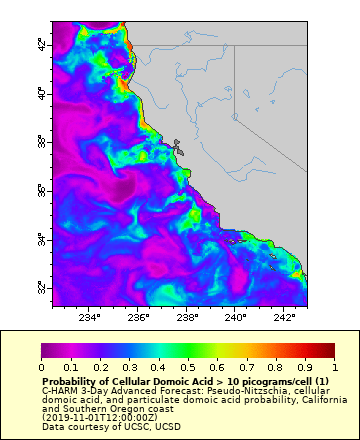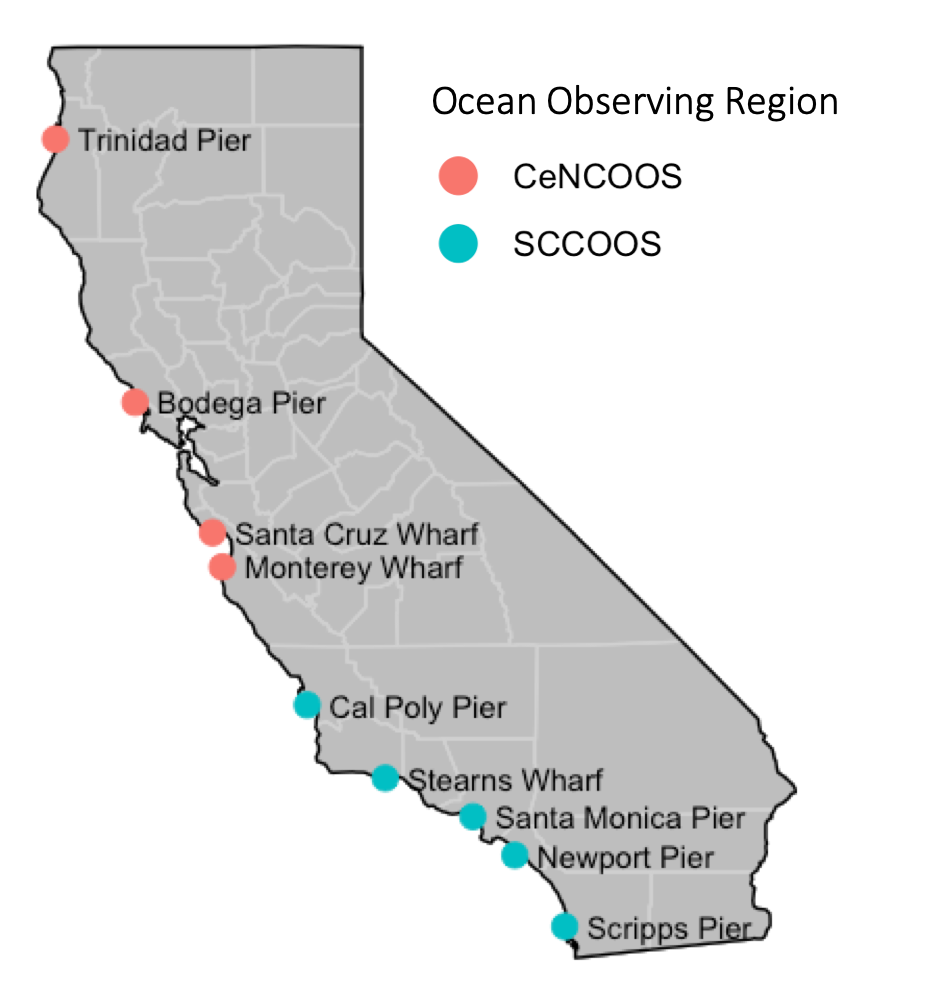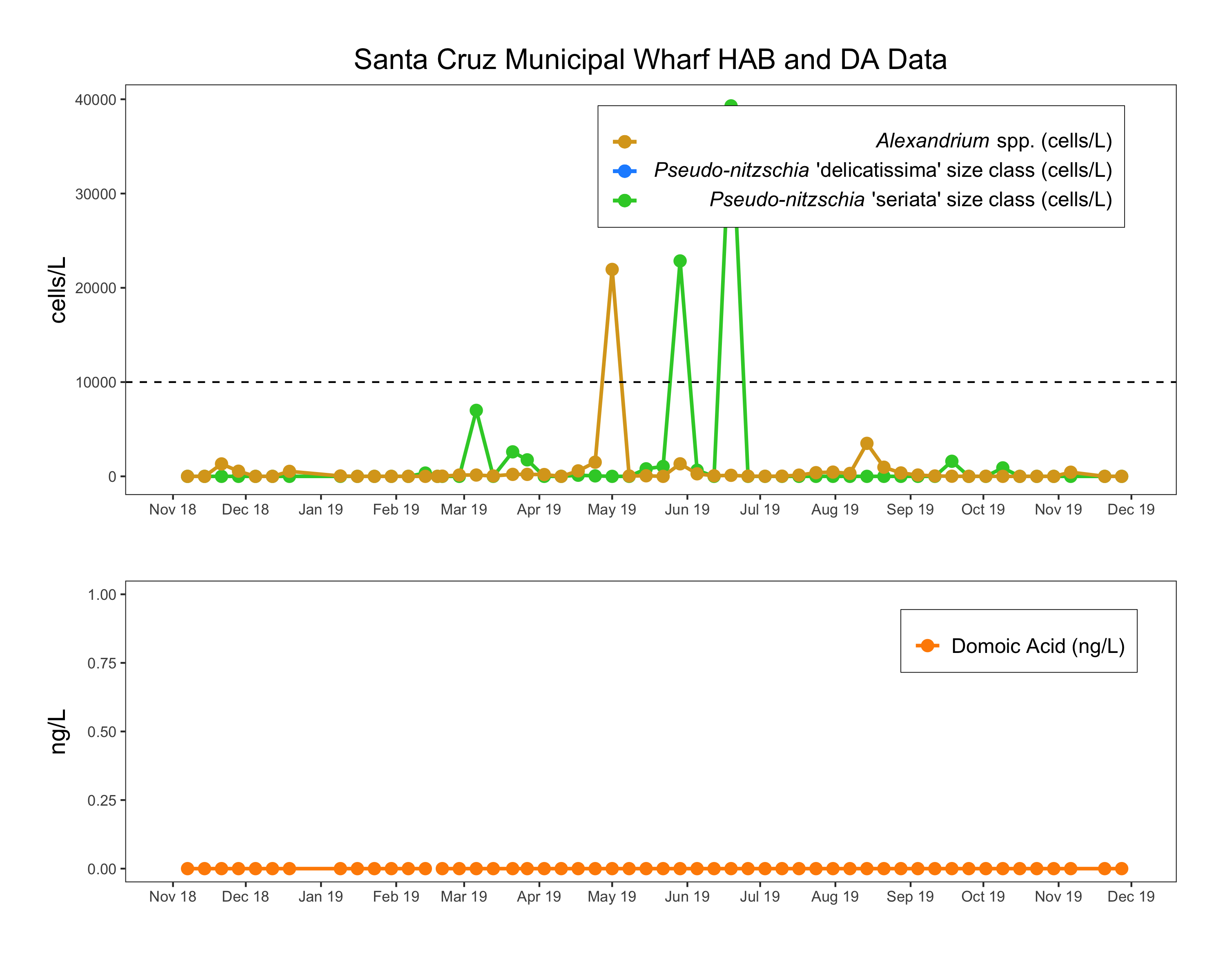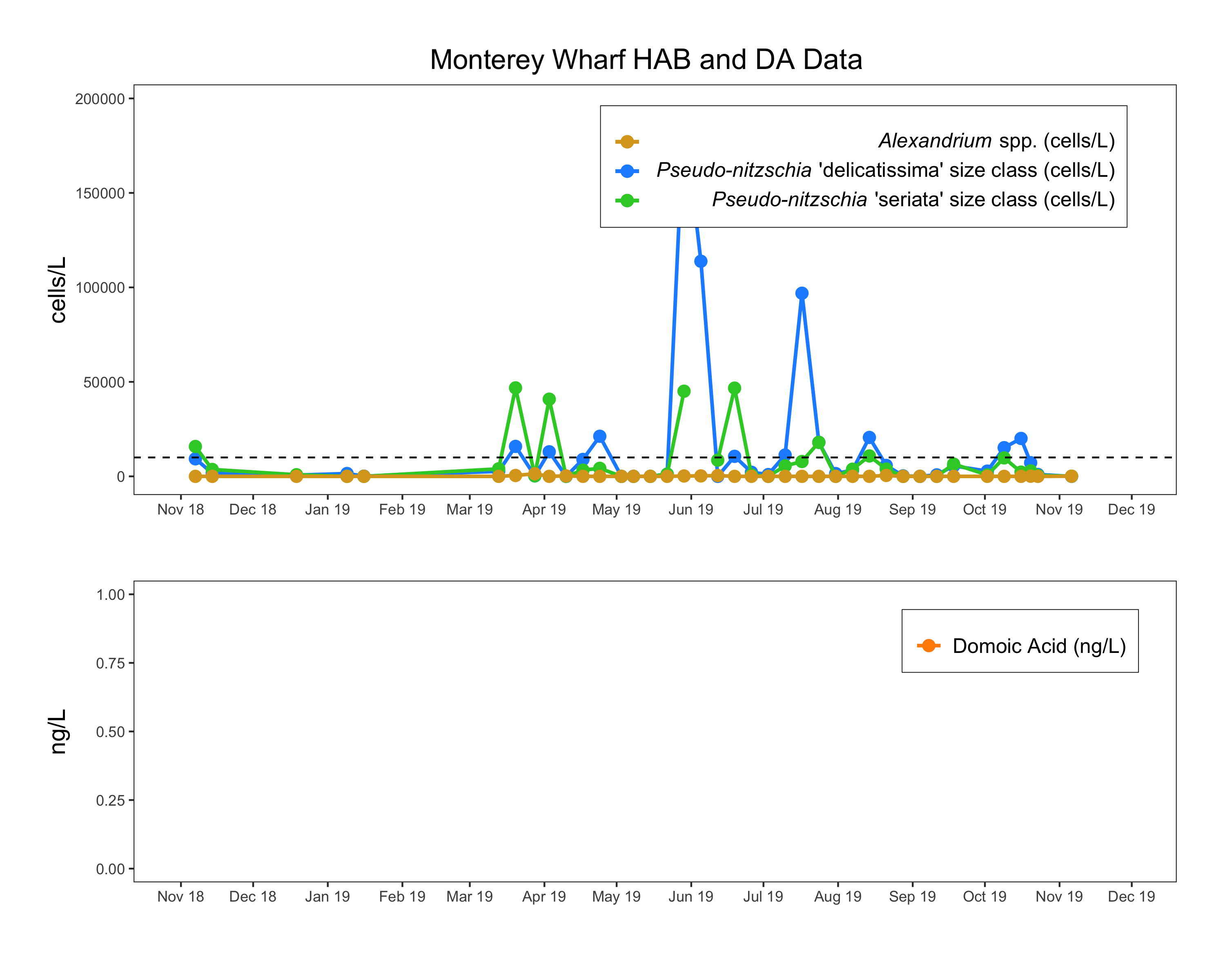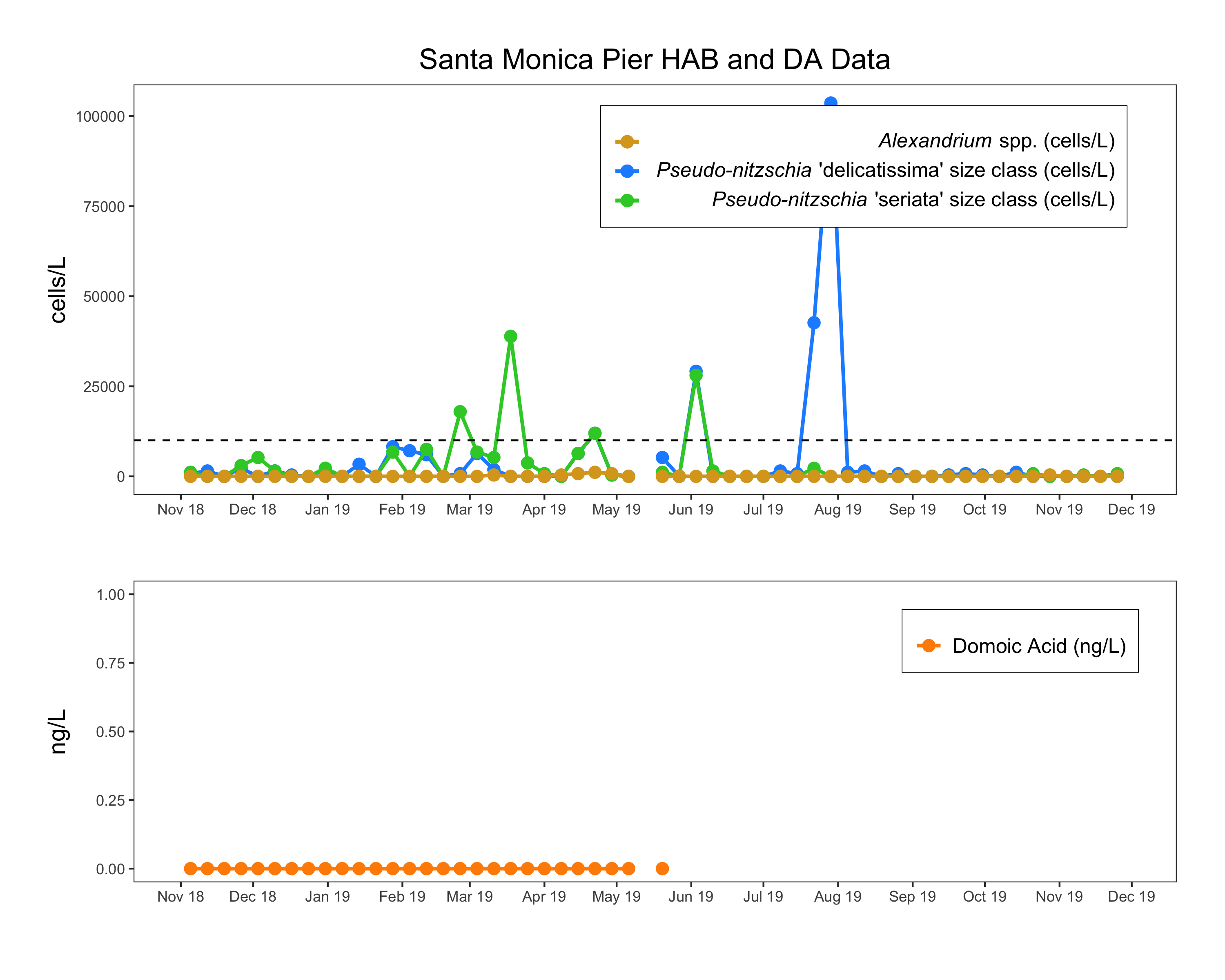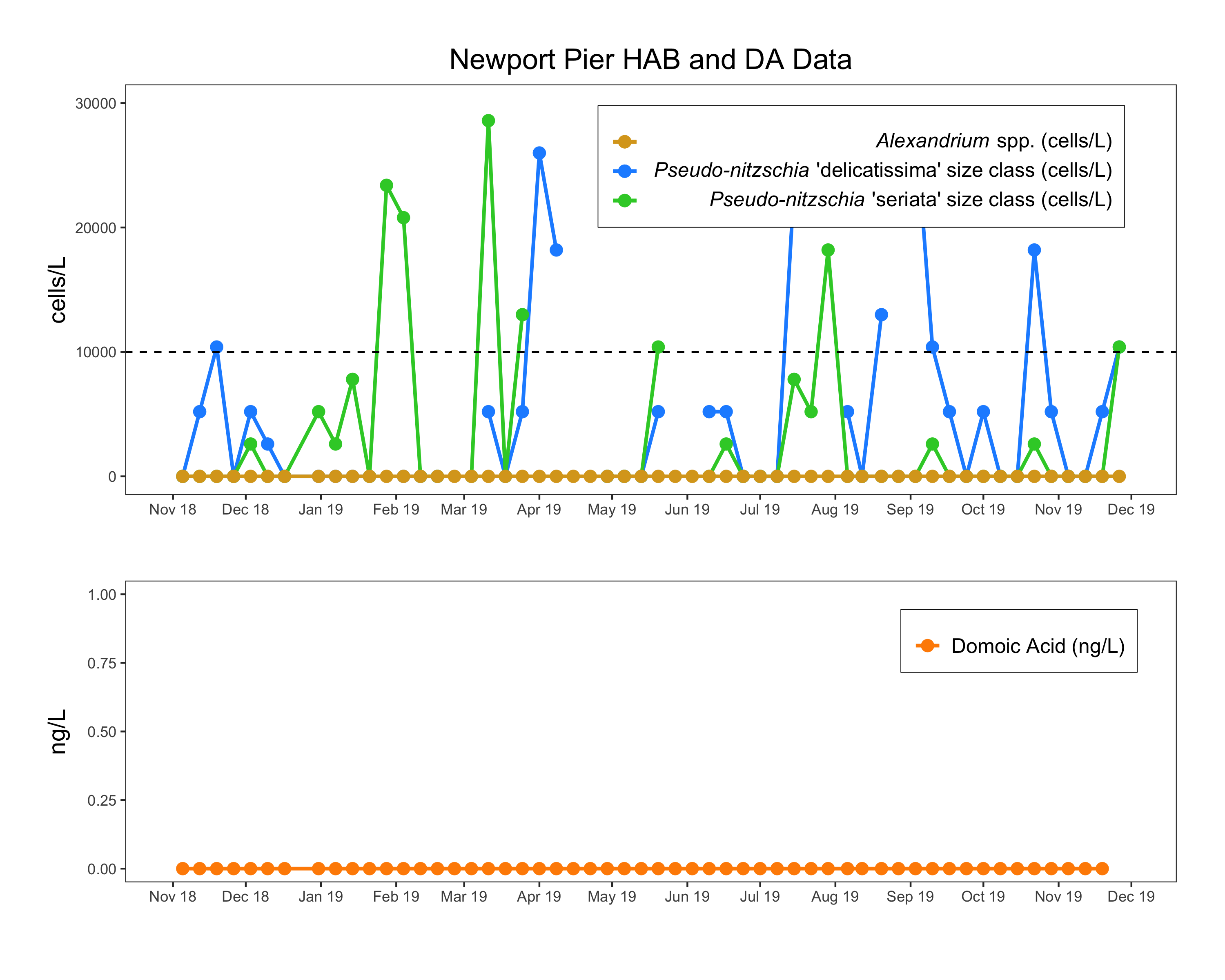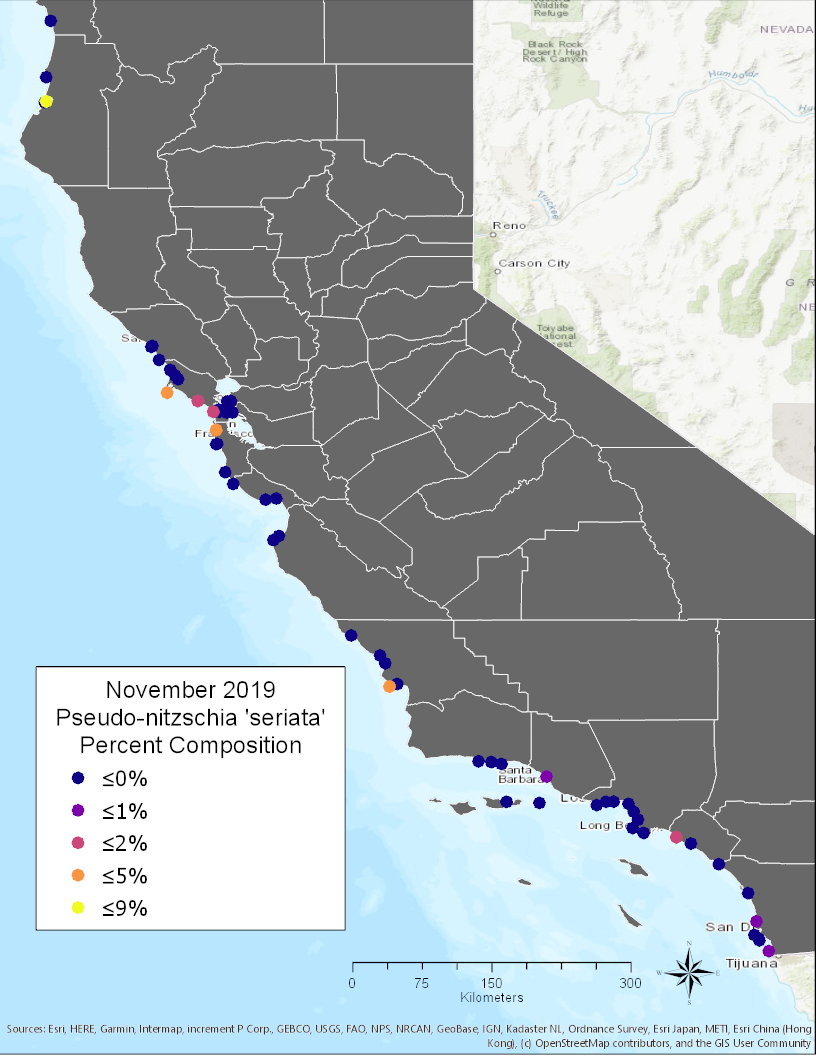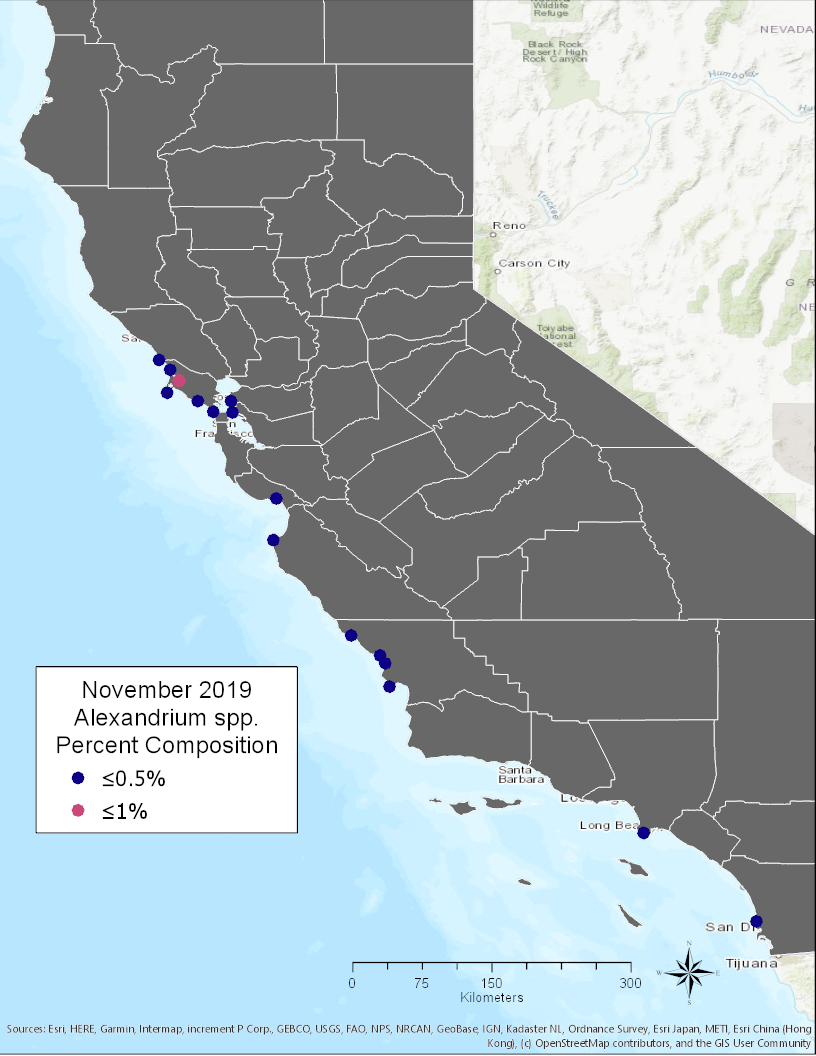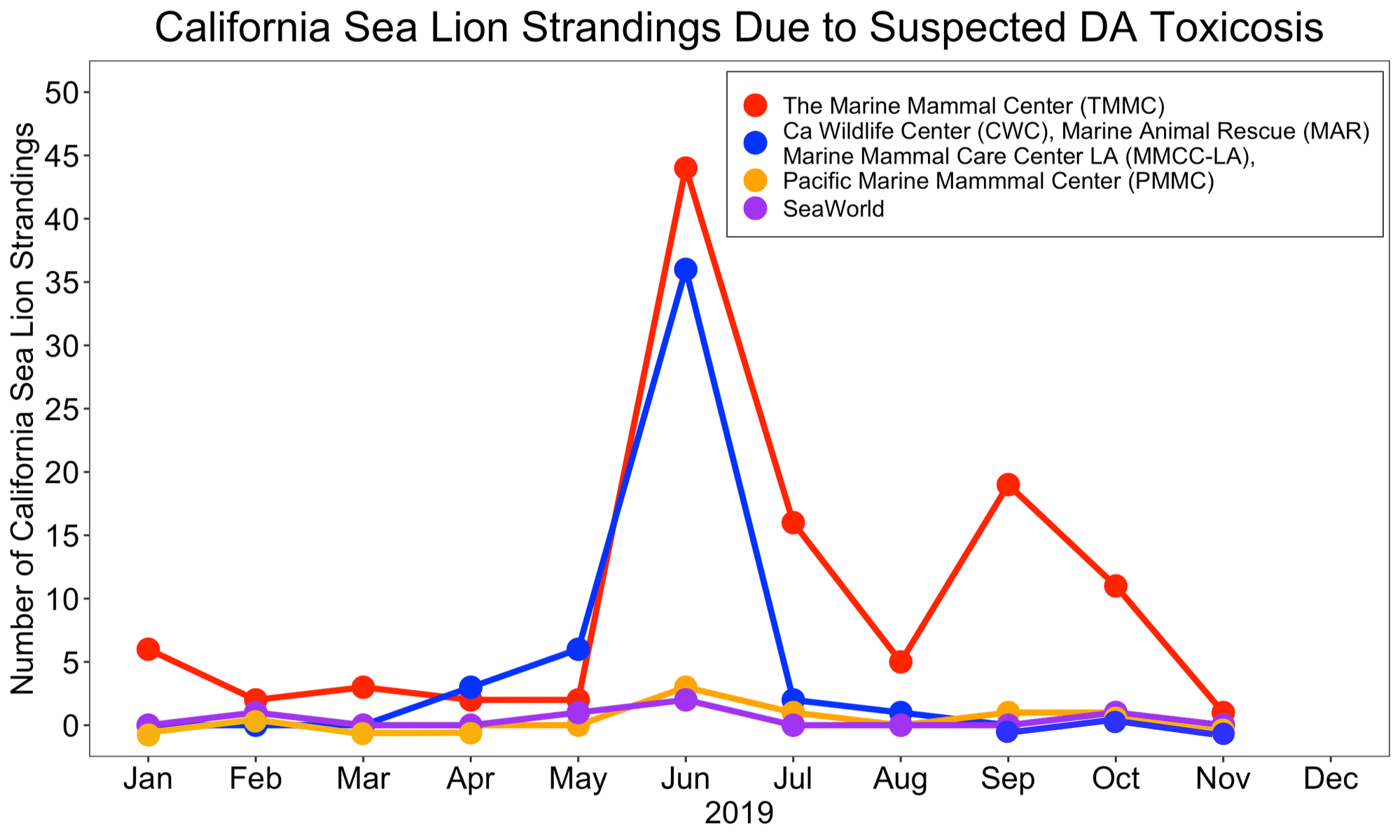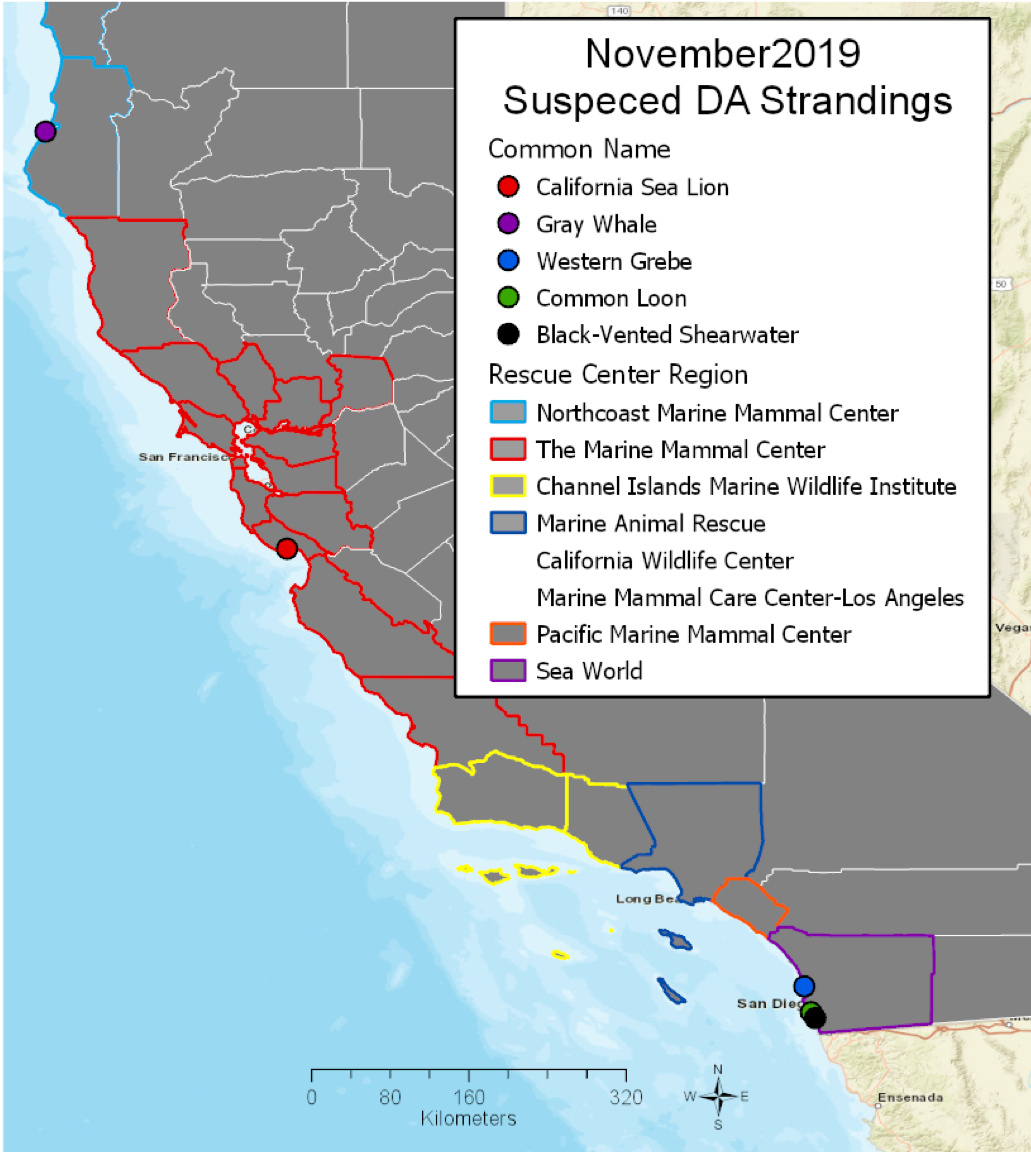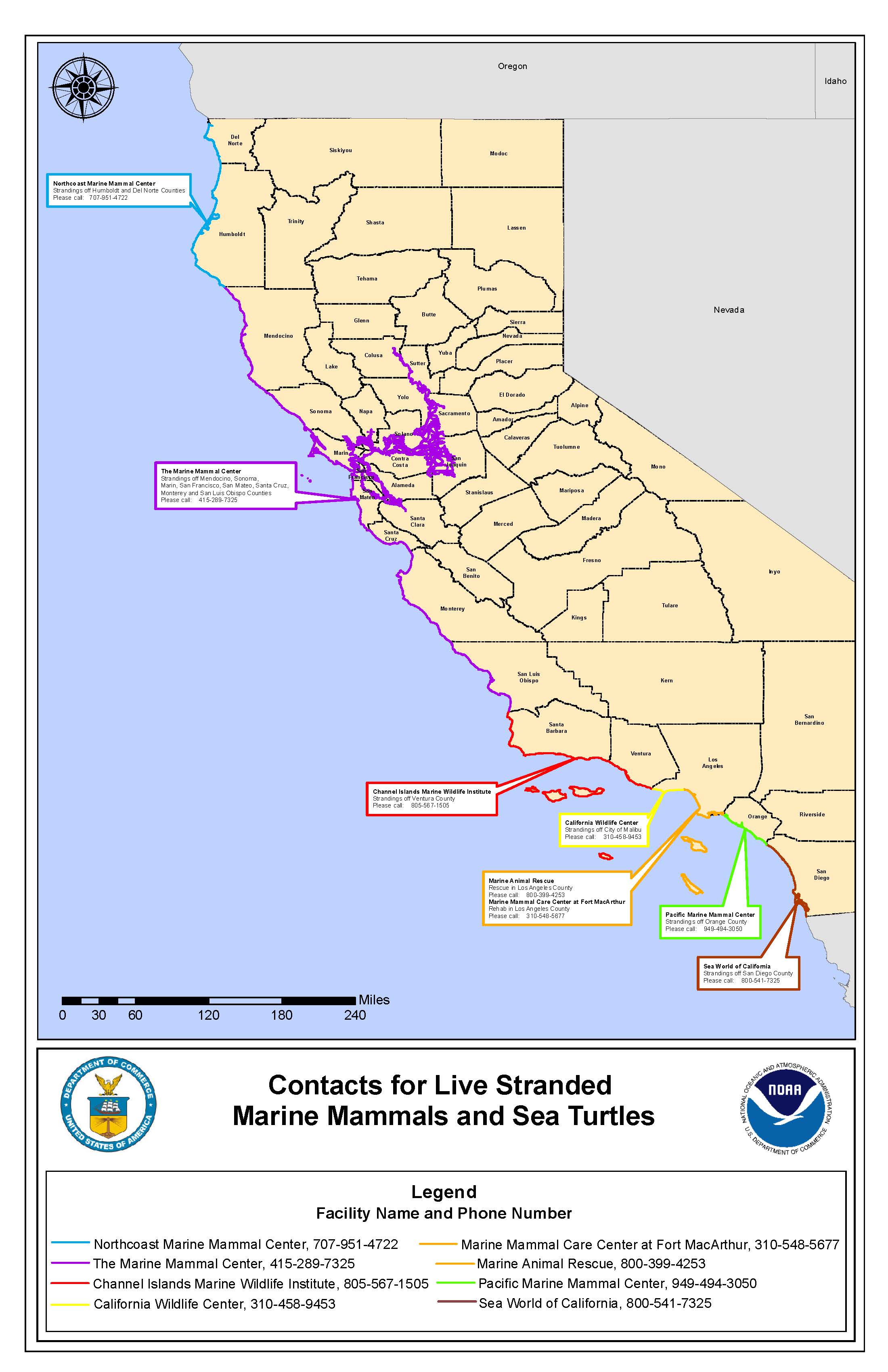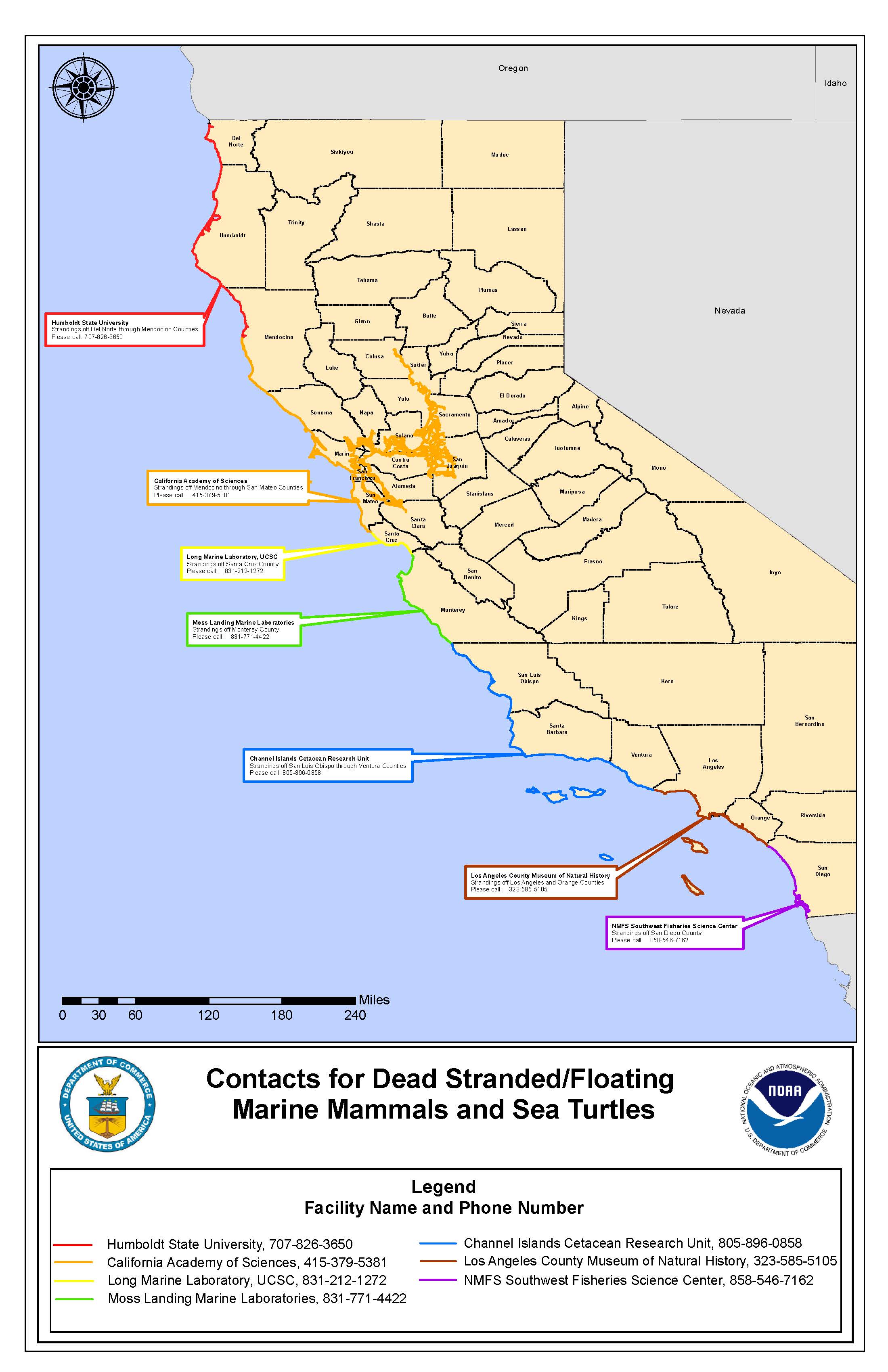Pseudo-nitzschia - C-HARM tells us where conditions are suitable for species of the diatom Pseudo-nitzschia spp. (all size classes) to grow well and where they might be more likely to produce domoic acid (DA). In keeping with the patterns in the model for quite some time now, suitable habitat for Pseudo-nitzschia spp. was spread throughout coastal California in November, but with only coastal ribbons of high probability in the Bight south of the Santa Barbara Channel. Habitat suitability for Pseudo-nitzschia spp. greatly increased in intensity over large swaths of the central and north coasts at different times throughout the month. C-HARM predicted high but patchy probabilities of high particulate DA (pDA) throughout most of the state, with the greatest probabilities of pDA along sections of the Humboldt/North County coastline, Sonoma coastline, Half Moon Bay, the southern portion of Monterey Bay, and the Southern California Bight (including the Santa Barbara Channel and the transition region around Pt Conception). Unlike in October and prior months, pDA probabilities were quite high at times along the San Luis Obispo coastline and offshore waters, which is consistent, albeit with a month lag, with the higher Pseudo-nitzschia spp. abundances measured by CDPH in that zone in October. In November, pDA probabilities were notably low outside SF Bay for most of the month. Persistent high probabilities in the Bight south of the Santa Barbara Channel seem to be due to a two-year long salinity anomaly that is driving the pDA model to over-predict the probability of domoic acid, however, this is still under investigation. Without offshore validation data of pDA, it is impossible to know the veracity of the C-HARM model predictions, with false positives and false negatives both possible.
Salinity is not an important component of the cellular DA (cDA) model, and we do not see the same hypothesized over-prediction pattern in the cDA model output, which may suggest that cDA may be better constrained for evaluating regions with greater DA risk. Following that logic, the "hottest" regions were predicted to be the North Coast (Del Norte and Humboldt Counties) followed by the Sonoma/Marin County coastline, the central coast near San Luis Obispo county, the Santa Barbara Channel region and around Pt. Conception, as well as patches within the Bight. In contrast to pDA, cDA probabilities were often elevated outside the SF Bay. This may indicate that the positive relationship with salinity that drives the pDA model is suppressing pDA in that region after rainy periods (e.g. first flush) when freshwater is prevalent, but that a HAB response is still likely in those offshore waters, given what the cDA model is telling us.
In comparison with the Harmful Algal Bloom Monitoring and Alert Program (HABMAP) measurements where we have November data currently available, bloom levels of the P. "delicatissima" size class occurred at the end of the month in the Southern California Bight at Scripps Pier (San Diego Co.) and Newport Beach Pier (Orange Co.), where the toxigenic class of P. "seriata" also hit bloom levels (although with no concomitant rise in DA levels). Bloom levels of Pseudo-nitzschia spp. were not observed at Santa Monica Pier (Los Angeles Co.) or Stearns Wharf (Santa Barbara Co.) in the month of November. November HABMAP data were not yet reported for Cal Poly Pier or Monterey Wharf. There were no Pseudo-nitzschia spp. present nor DA activity at Santa Cruz Wharf in November. This is inconsistent with high C-HARM pDA probabilities predicted for Monterey Bay but is aligned with the generally low cDA probabilities predicted for the northern Monterey Bay, where the Santa Cruz Wharf is located.
CDPH recorded their highest relative abundances of Pseudo-nitzschia seriata size class for November along the North Coast. Moderate abundances were observed outside the SF Bay in Marin County, consistent with elevated cDA predictions in that area, as just described. Low CDPH Pseudo-nitzschia seriata counts in northern Monterey Bay are also consistent with HABMAP observations at Santa Cruz Wharf. Moderate Pseudo-nitzschia seriata abundance near Cal Poly Pier is consistent with the change (rise) in pDA and cDA probabilities noted there from October to November, but HABMAP results are not yet available to confirm any DA present at the pier. The November 1st health advisory issued for Dungeness crab due to the threat of Amnesic Shellfish Poisoning (ASP) from DA that took place in parts of Humboldt and Marin Counties was lifted on November 22nd for parts of Marin County (from Point Reyes to Pillar Point) and on December 10th for parts of Humboldt County (from Shelter Cove to Point Arena) indicating that DA was elevated in crab tissue for most of November in parts of Humboldt and Marine Counties. Interestingly, a local minimum in cDA probabilities does occur along the Marin and Sonoma County coastlines by mid-November. However, it is followed by very high probabilities at the end of the month, which could be suggestive of future problems. The recreational shellfish harvest quarantine was lifted on October 31st, for all areas except for Humboldt and Mendocino counties. These counties remained under quarantine due to DA levels in mussels until November 22nd and December 20th respectfully. Again, C-HARM does show local minima in cDA probabilities in parts of Humboldt County, but these are replaced by very high probabilities later in the month.
Animal strandings from suspected DA toxicosis were much lower in November than October according to the rescue institutions that contributed in this reporting cycle. Only two marine mammals were reported, and their stranding locations correspond with regions of elevated nearshore and offshore DA predictions from C-HARM (Monterey Bay and Humboldt). Interestingly, SeaWorld reported three suspected DA-related bird strandings in San Diego County spread throughout the month, which is consistent with C-HARM predictions of patchy nearshore (and some offshore) DA probabilities in the SD area. The highest C-HARM cDA probabilities were predicted early in the month when Pseudo-nitzschia spp. abundance was on the decline at Scripps Pier. Later in the month, P. "delicatissima" bloomed as the more toxigenic P. "seriata" size class was on the rise at Scripps Pier.
Alexandrium - There was virtually no activity related to Alexandrium spp. or paralytic shellfish (PSP) toxins seen in HABMAP or CDPH records for November.
Note that data for some stations are not shown because they are not yet recorded in the public HABMAP archive.
Differentiating Pseudo-nitzschia species by light microscopy is difficult. For this reason, Pseudo-nitzschia "seriata" does not refer to an actual species but rather the larger size class of Pseudo-nitzschia, which is generally a more toxigenic group of species. Alternatively, Pseudo-nitzschia "delicatissima" refers to the smaller size class that is generally non-toxigenic. The dashed line on the plots demarcates the 10,000 cells/L "bloom" threshold designated here for Pseudo-nitzschia populations only.
More information on the statewide HAB network and forecasting system can be found here and on the SCCOOS HABMAP page.
Santa Cruz Wharf
Water samples were collected at Santa Cruz Wharf three times in the month of November. Pseudo-nitzschia seriata group was not detected in any of the water samples and Alexandrium were detected below bloom levels on November 6th. Domoic acid results are not yet available for the month of November. Santa Cruz Wharf does not count for Pseudo-nitzschia delicatissima group.
Monterey Wharf
Water samples were collected at Monterey Wharf on November 6th. Pseudo-nitzschia delicatissima group was not detected and Pseudo-nitzschia seriata group and Alexandrium spp. were detected below bloom levels. Domoic acid results are not yet available for the month of November.
Cal Poly Pier
Cal Poly Pier phytoplankton counts and domoic acid results are not yet available for the month of November.
Stearns Wharf
Water samples were collected at Stearns Wharf four times in the month of November. Pseudo-nitzschia seriata group and Pseudo-nitzschia delicatissima group were detected in all three water samples, but Pseudo-nitzschia delicatissima group was only detected above bloom levels on November 12th. Alexandrium spp. were not detected in any of the samples. Domoic acid results are not yet available for the month of November.
Santa Monica Pier
Water samples were collected at Santa Monica Pier four times in the month of November. Pseudo-nitzschia delicatissima group and Alexandrium spp. were not detected in any of the samples. Pseudo-nitzschia seriata was detected below bloom levels on November 11th and 25th. Domoic acid results are not yet available for the month of November.
Newport Beach Pier
Water samples were collected at Newport Beach Pier four times in the month of November. Pseudo-nitzschia delicatissima group and Pseudo-nitzschia seriata group were detected above bloom levels on November 26th. Alexandrium spp. and domoic acid were not detected in any of the November water samples.
Scripps Pier
Water samples were collected four times at Scripps Pier in the month of November. Pseudo-nitzschia delicatissima group and Pseudo-nitzschia seriata group were detected in all the water samples with Pseudo-nitzschia delicatissima group detected above bloom levels on November 25th. Alexandrium spp. were not detected in any of the water samples and domoic acid results are not yet available for the month of November.
CDPH observations for Pseudo-nitzschia spp. and Alexandrium spp.
Please note CDPH recently moved to only reporting Pseudo-nitzschia of the seriata complex and not all Pseudo-nitzschia spp. as previously provided.
From 1-30 November 2019, water samples were collected by volunteers and sent to the California Department of Public Health (CDPH) for analysis. Pseudo-nitzschia seriata group were detected in 48 of the 129 samples. Pseudo-nitzschia seriata group were recorded at low density levels (1-9 percent composition) in 12 of the samples and were recorded at less than 1% composition in 36 samples.
Alexandrium spp. were detected in all 21 samples in the month of November, but at low density levels (<1% composition). You can also view CDPH weekly map layers of Pseudo-nitzschia and Alexandrium spp. here.
Data are provided by the California Department of Public Health, Environmental Management Branch.
CDPH and OEHHA Health Advisories
California Department of Fish and Wildlife (CDFW) Director Charlton H. Bonham issued a declaration delaying the Nov. 22, 2019 start date for the California Dungeness crab fishery south of the Sonoma/Mendocino county line until December 15, 2019 due to significant risk of marine life entanglement from fishing gear.
On November 19th, CDPH lifted the October 15th shellfish safety notification related to sport-harvested mussels, whole scallops, and clams (other than razor clams) in Humboldt County and on December 20th lifted the safety notification for Mendocino County.
On November 1st, the California Department of Public Health (CDPH) warned consumers not to eat the viscera (internal organs) of Dungeness crab caught in coastal waters due to the detection of elevated levels of domoic acid, a naturally occurring toxin. On November 22nd CDPH lifted the health advisory for Dungeness crab caught in state waters in parts of Marin County (from Point Reyes to Pillar Point) and on December 10th in parts of Humboldt County (from Shelter Cove to Point Arena).
For the latest closures and updates, please visit the CDFW Health Advisories page as a central location of information related to CDPH and/or OEHHA health advisories.
On July 30, 2019 the Office of Environmental Health Hazard Assessment (OEHHA) hosted the Domoic Acid Webinar: Research on Effects of Repeat Low-Level Exposures and Its Implications for Human Toxicity. The recorded webinar can be found here.
Domoic acid (DA) is a potent neurotoxin produced by some diatom species of the genus Pseudo-nitzschia. Species exposed to DA can result in seizures, epilepsy, cardiomyopathy, and death depending upon the ingested dose. DA toxicosis commonly occurs in California Sea Lions (Zalophus californianus), presumably due to a combination of foraging behavior and seasonal movements. The Marine Mammal Center (TMMC), the California Wildlife Center (CWC), the Marine Mammal Care Center Los Angeles (MMCC-LA), Marine Animal Rescue (MAR), the Pacific Marine Mammal Center (PMMC), and SeaWorld act like an emergency room by working to rescue and rehabilitate sick and injured marine mammals, seabirds, and sea turtles.
Among the six rehabilitation centers we have data for a total of two marine mammal strandings and three sea bird strandings presented with symptoms of domoic acid toxicosis in the month of November.
California Wildlife Center, Marine Animal Rescue and the Pacific Marine Mammal Center did not record any stradnings due to suspected domoc acid in November.
November strandings due to suspected DA toxicosis occurred in the following counties:
- Humboldt (TMMC)
- November 7th, adult male Gray Whale
- Santa Cruz (TMMC)
- November 10th, yearling female, California Sea Lion
- San Diego (SeaWorld)
- November 9th, Western Grebe
- November 10th, Common Loon
- November 21st, Black-Vented Shearwater
At this time we do not have data from the North Coast Marine Mammal Center or the Channel Islands Marine Wildlife Institute.
Please subscribe to CA HAB Bulletin listserv to receive the monthly CA HAB Bulletin.


